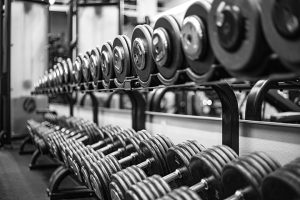 If you’ve been exercising and want to include weight training in your regimen, it can be intimidating, especially for beginners. How heavy should the weights be? What’s the best way to start? Is there a difference in how you train to build muscles and how you train to build strength? How many repetitions of each exercise should you do? These answers depend on what your ultimate goal is. There is a difference between training for bulk and training for strength.
If you’ve been exercising and want to include weight training in your regimen, it can be intimidating, especially for beginners. How heavy should the weights be? What’s the best way to start? Is there a difference in how you train to build muscles and how you train to build strength? How many repetitions of each exercise should you do? These answers depend on what your ultimate goal is. There is a difference between training for bulk and training for strength.
Learn to use each piece of equipment correctly.
There are dumbbells, barbells, kettlebells, and weight machines. Focus on learning to use one at a time. The easiest may be dumbbells since they don’t require a second person to spot. Dumbbells have more versatility, while barbells let you lift heavier loads. If you’re first starting, you won’t be focusing on the heaviest loads. You can use dumbbells to work both large and small muscle groups and do simple, single-joint exercises. You can use videos to learn the form, but you should have a full-length mirror or someone else watch you execute each move. No matter what type of weights you use, learning the proper form is imperative. A personal trainer is the ideal partner to help you learn.
Don’t overdo it or overwork your muscles.
If you start out trying to lift too heavy, it affects your form negatively. That can cause injury. If you overwork your muscles during the first session, you may be too sore or strain your muscles, putting you on the bench for weeks. Don’t train with weights every day or push to the maximum. When you workout to build muscles, the workout causes microtears in the muscles and the scar tissue makes them bigger after they heal. It takes 48 to 72 hours to heal. Without the rest, you’re tearing down the muscle. One solution is working different muscle groups, resting those you’ve previously worked.
Train to reach your goal.
While both bulk and strength use weight training, they train differently. To build bulk, you use lighter weights and work toward failure. To build strength, you increase the weight until you reach failure and do fewer repetitions. Form is the key to both goals. Even if you’re working toward strength, start lighter and focus on form. If you’re using barbells, that may mean starting by lifting the bar without weights added.
- A great body starts in the kitchen. You need between 20 and 30% of your calories from protein. Don’t reduce your calorie count too much if you’re also trying to shed pounds.
- Eating pre-workout or post-workout snacks can help build muscles and improve your workout. Eating before a workout makes it better and starts the recovery process. Eating afterward boosts recovery and builds muscle tissue.
- Don’t forget to do warm-up and cool-down exercises. Warm-up exercises help prevent injury. Cool-down exercises increase circulation and improve recovery while reducing potential muscle pain.
- Consistency is the key to any exercise program, whether it’s strength, endurance, flexibility, or balance. Stick with a consistent schedule and exercise at the same time each day so it becomes a habit.
For more information, contact us today at LIV Fitness
